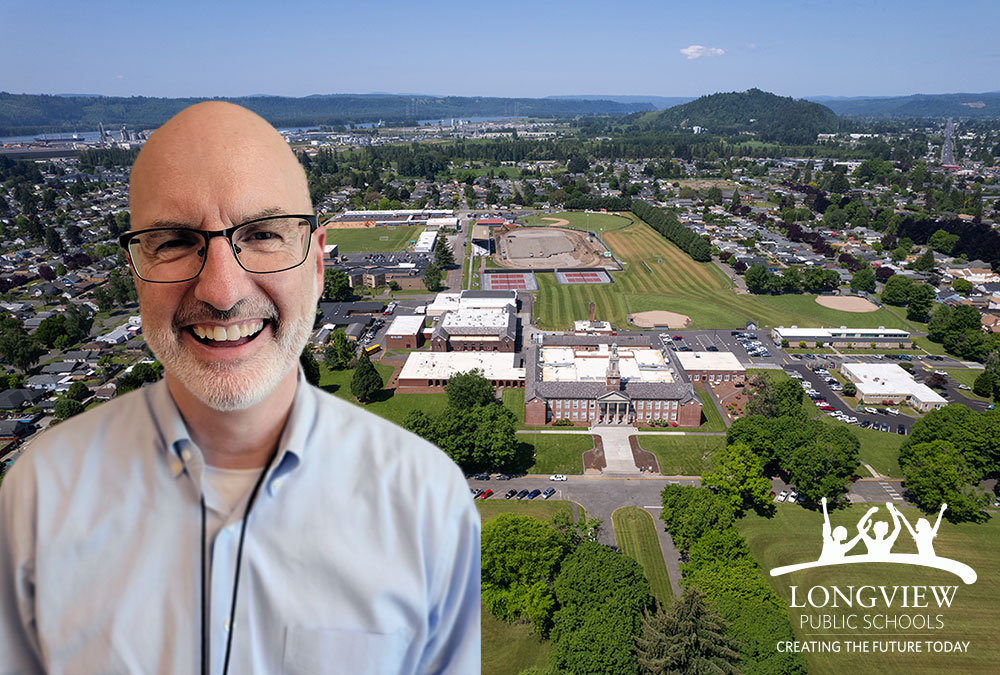You are currently the Executive Director of Communications and Operations, but I’ve heard you were a “newspaper man” before that. How did your career unfold? What made you move from journalism and media to communications?
My career began with a bachelor’s degree in accounting, and I initially worked in accounting roles—but quickly discovered it wasn’t the right fit for me. That led to a transition into marketing and advertising at a large retail corporate office. From there, I moved into media, becoming an advertising salesperson for The Seattle Times Company. I was later promoted to division general manager, then took on leadership roles at other major publishing companies. I ultimately served for over a decade as President and Publisher of daily newspapers across the country.
As the media industry began to decline, I made the decision to shift into public sector communications. That brought me to Longview Public Schools, where I started in communications and soon after was asked to take on additional operational responsibilities, including facilities, maintenance, transportation, custodial services, and safety and security.
Did your additional responsibilities come about through a shrinking of district office staff? I know a lot of communicators find themselves with “extra duties as assigned” as budgets tighten. What piece of advice would you give to someone who is experiencing that situation?
When I joined the district, the superintendent was directly supervising the operations team and was stretched far too thin. By shifting those responsibilities to me, he was able to focus more on supporting principals, while I could provide the daily management and strategic planning the operations department needed to improve efficiency and results significantly.
At the same time, the superintendent wanted to place greater emphasis on emergency preparedness, so I also took on district-wide safety and security responsibilities. Before working in education, I managed newspaper companies with hundreds of employees and multiple department heads, so taking on a broader scope of responsibility is something I’ve been doing for more than a decade.
My advice for anyone in a similar situation is to embrace the opportunity to add value, look for ways to make systems and processes more efficient, and leverage your past leadership experience to manage a wider scope effectively. The key is to treat the added responsibilities not as “extra duties” but as a chance to make a measurable difference for the organization.
How long have you lived in Longview?
My wife and I have lived in Longview for 16 years. My son, Troy, graduated from R.A. Long High School here in town.
How did your perception of the school district change when you went from being a parent and private sector manager to a school administrator?
Coming from the for-profit business world, where decisions revolve around speed, competition, and quarterly results, the transition to public education meant adapting to a culture built on consensus, transparency, and service to the community. In education, success isn’t measured in immediate returns — it’s about long-term student growth, safety, and equity, which require patience and a wider circle of stakeholders in every decision.
My experience managing newspaper companies taught me how to lead diverse teams, make operational systems more efficient, and relentlessly focus on outcomes. In public education, I’ve applied those skills while learning to navigate the additional layers of accountability to school boards, parents, and the public. At its core, the education climate is more relationship-driven, and the work is deeply mission-focused — the “bottom line” is helping every student succeed.
You are well-known in the region for being very proactive about safety communications. Do you think wearing multiple hats in the district helps you identify safety communication needs?
Absolutely. Having a direct role in areas like safety and operations gives me a deeper understanding of the issues school administrators are facing. That insight helps inform timely, proactive communication. The more you understand a topic—especially one as sensitive and important as school safety—the more effective your messaging can be.
Last year Xander and I helped you produce a safety video for the district. Can you give a bit of background into why you decided to make this video?
In Longview, we conduct scientific community surveys every two years to gauge local priorities. Time and again, school safety and security emerge as top concerns—especially for parents. We also know from experience that whenever there’s a tragedy reported in the news, our phones light up with parents asking how we’re keeping their kids safe.
Given how important this issue is, we felt it was necessary to proactively communicate our safety efforts. That’s why we partnered with ESD 112 to create the safety video. We launched the video at the beginning of the 2024-25 school year, and not long after, when school violence was again in the national headlines, we noticed parents making positive comments on our safety video posts. We plan to use the video again this fall.
Longview’s safety video produced in partnership with ESD 112 Communications
What were some of the challenges in producing a video about the district’s safety and security practices?
The biggest challenge was finding the right balance. We wanted to inform the public and reassure families, without causing unnecessary fear or anxiety. The tone had to reflect both transparency and calm confidence that student and staff safety is our highest priority.
What have been the benefits of the video? Have you received any feedback on it? Would you recommend that other districts make their own?
We’ve seen positive outcomes both anecdotally and through our survey data. Nationally, trust in public schools has declined in recent years, but in our community, perceptions of Longview Schools have held steady—or even improved in some areas.
In our most recent election (February 2024), our Educational Programs and Operations levy passed with 63.6% approval—substantially higher than neighboring districts. We believe proactive communication, such as the safety video, help build trust and reinforce community support. I would absolutely recommend that other districts consider developing their own safety communications. It’s an investment in transparency and public confidence—and ultimately, in student well-being.


